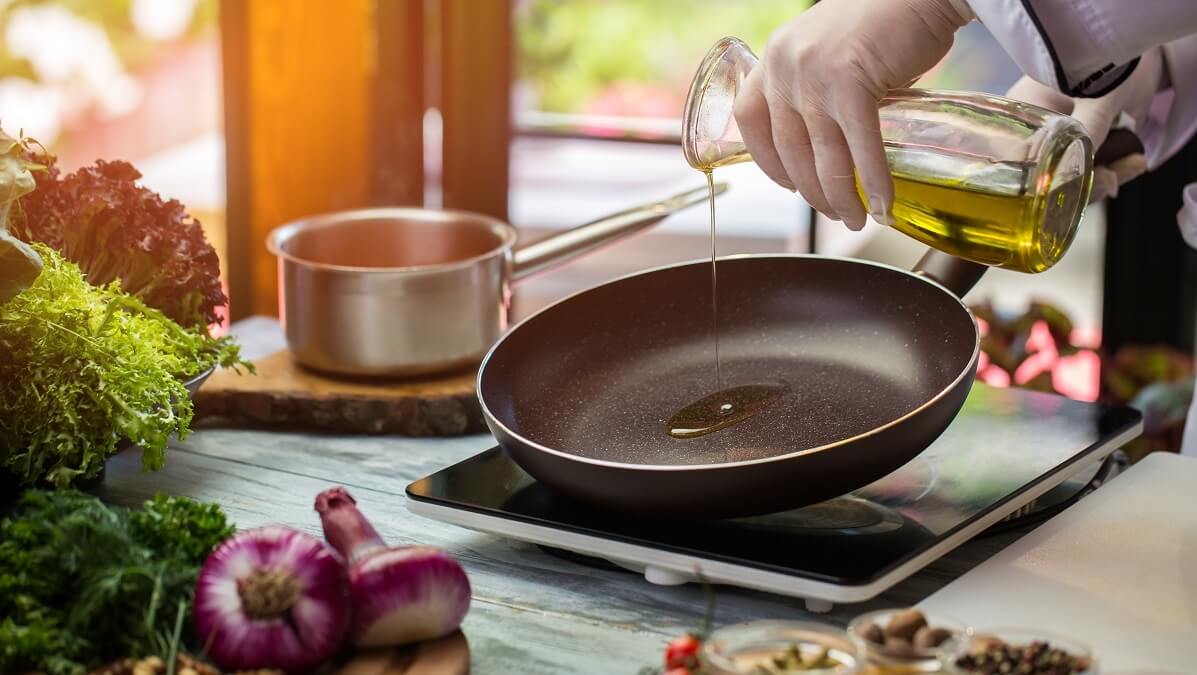How many bottles of oil do you have in your pantry? I’ve just done a stocktake and this is what I have: olive oil, extra virgin olive oil, macadamia oil, truffle oil, avocado oil, peanut oil, coconut oil, sunflower oil, vegetable oil, sesame oil. Ridiculous?
Well, it seems I can toss out most of those.
Dietitian and nutritionist Susie Burrell says: “Australian extra virgin olive oil should be the only oil you use, both for cooking and as a salad dressing.”
You probably know that extra virgin olive oil is a pivotal component of the much-lauded Mediterranean diet and Australian extra virgin olive oil is a superior quality product.
Ms Burrell says it has exceptionally high levels of antioxidants, which act as a natural anti-inflammatory protecting cells from damage.
She also urges consumers to pay more attention to the oils being used to make foods. “Scan ingredient lists and avoid any packaged foods that are made with palm or vegetable oils as those will increase the pro-inflammatory omega-6 fats in your diet.
“Instead, seek out foods that list olive oil or high-oleic sunflower oil among their ingredients.”
So what’s wrong with other oils and omega-6 fats?
Healthline says that for cooking, we should limit our use of plant oils that are high in omega-6 – as well as processed foods that contain those oils. Those oils include: soybean, corn, sunflower, peanut, sesame and rice bran.
The Health Sciences Academy says: “Those oils have unstable fats and will decimate the nutritional properties of your food. And they’ll give you a big fat health risk in the meantime.”
Scientists have hypothesised that too much omega-6 relative to omega-3 may contribute to chronic inflammation, which is an underlying factor in some of the most common Western diseases, including heart disease, cancer, diabetes and arthritis.
The academy also supports the use of olive oil, saying it is “an excellent example of a healthy alternative to vegetable oil that’s low in omega-6”.
That is all very well for households with a reasonable weekly budget. A three-litre can of several Aussie extra virgin olive oils, for instance, costs about $46 when not on special. Spanish and Italian oils cost about the same.
But there is a strong incentive to buy Aussie oils.
Olive oil is one of the most fraudulently labelled foods in Europe and one of the most often investigated, according to a 2022 report by the European Commission.
Recent reports out of Brazil and Spain detailed the seizing of massive hauls of oil labelled as extra virgin olive oil but which contained other products, such as soybean oil. Those frauds are being discovered via nuclear magnetic resonance testing.
And, the price of olive oils is climbing dramatically.
The Economist says extra virgin olive oil is becoming a luxury. “In September, prices reached their highest level since records began, rising by 117 per cent year on year, according to the International Monetary Fund. Olive oil is 17 times as valuable as crude oil weight for weight. In 2019, it was seven times cheaper.”
Why has the price shot up?
There was a drought in Spain (the world’s largest producer of the extra virgin variety) in 2022 and the harvest in Italy was below average. In Australia, producers reported mixed results from the 2023 harvest, with some growers enjoying an abundant harvest and others not harvesting at all.
Cool weather and labour issues resulted in a lower yield than expected for many, although growers said the quality was excellent.
WomensHealth.com.au can have the final word – or rather warning. “Olive oil’s health credentials diminish when it reaches a certain temp, thanks to its low smoke point. This is when the oil begins to break down and burn, producing harmful compounds. Olive oil’s smoke point of 160°C to 190°C makes it unsuitable for high temp cooking compared with refined olive oil’s higher smoke point of 200°C to 220°C.”
So, extra virgin olive oil is best – mostly.
Are you a fan of Australian extra virgin olive oil? Do you keep other oils in the pantry? Share your views in the comments section below.
Also read: Can this oil really boost hair growth?


I only buy Australian evoo simply even though it is typically less pungent than imported spanish and italian oils. The downside of evoo is the low smoke point, which makes it unsuitable for wok stirfry, and I prefer to use peanut or rice bran for high temp cooking.
This article does not mention Canola Oil which we mostly use for cooking.
Our olive oil is for salads.
Please never use canola oil. It is particularly toxic being highly processed, deodorised and contains trans fats.
I agree – if anyone wants to explore the subject further
Dr. Chris Knobbe reveals startling evidence that seed oils, so prevalent in modern diets, are the reason for most of today’s chronic diseases., especially macular degeneration.
At the root of the harmful biochemical reactions enacted by seed oils is linoleic acid, says Knobbe, which is an 18-carbon omega-6 fat. Linoleic acid is the primary fatty acid found in PUFAs and accounts for about 80% of total vegetable oils. Omega-6 fats must be balanced with omega-3 fats in order not to be harmful.
“Most of this linoleic acid, when it oxidizes, it develops lipid hydroperoxides and then these rapidly degenerate into … oxidized linoleic acid metabolites,” says Knobbe.13
The oxidized linoleic acid metabolites are a perfect storm. They are cytotoxic, genotoxic, mutagenic, carcinogenic, atherogenic and thrombogenic, says Knobbe. Their atherosclerosis and thrombogenic actions are especially concerning because they can produce strokes and clots.
PUFAs Create Insulin Resistance
https://podcasts.apple.com/au/podcast/dr-chris-knobbe-reversing-arthritis-via-diet-diseases/id1511122216?i=1000505455991
This article is misleading in that high temperature frying of food destroys olive oil’s nutritional value and other oils like sunflower are much better for this purpose